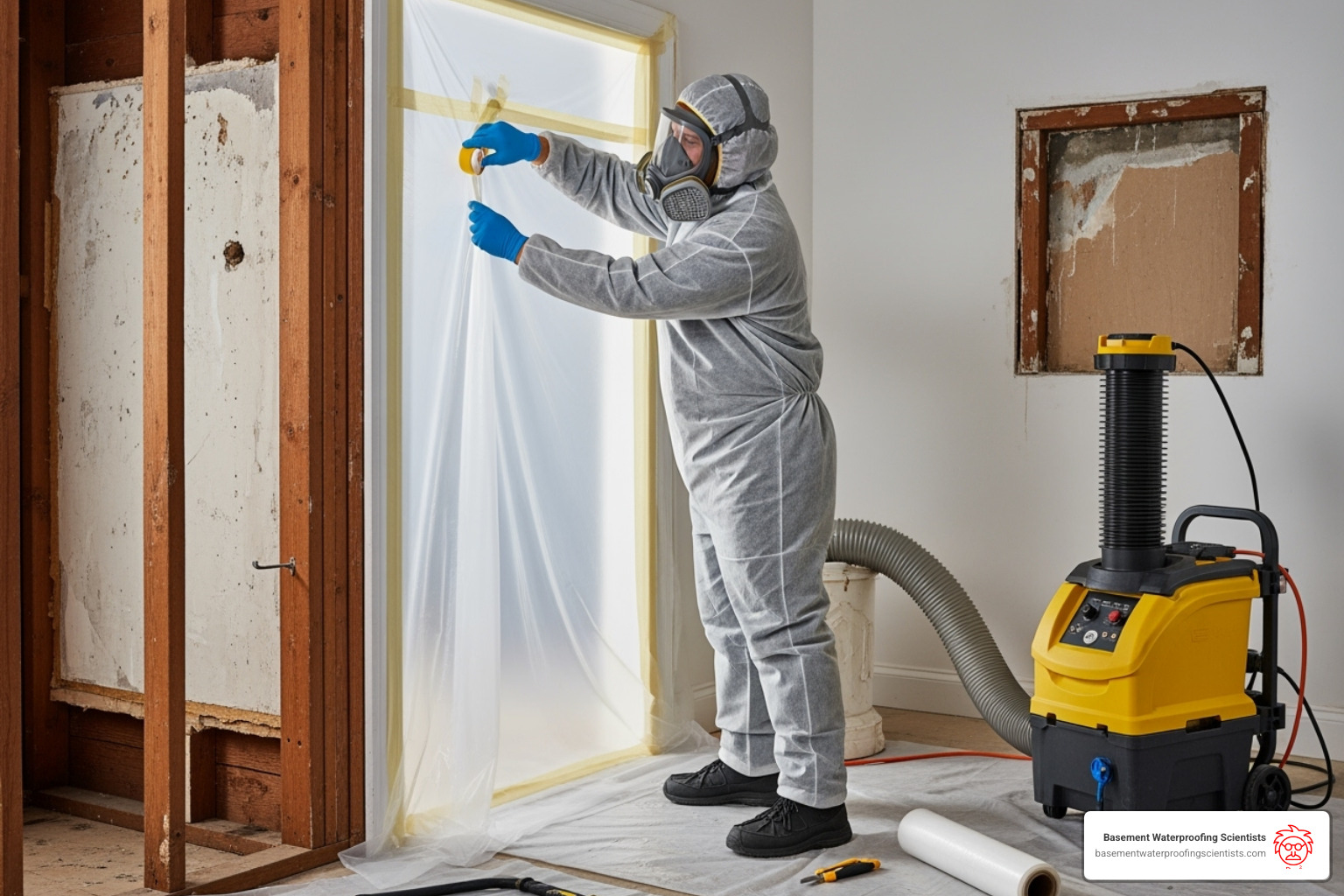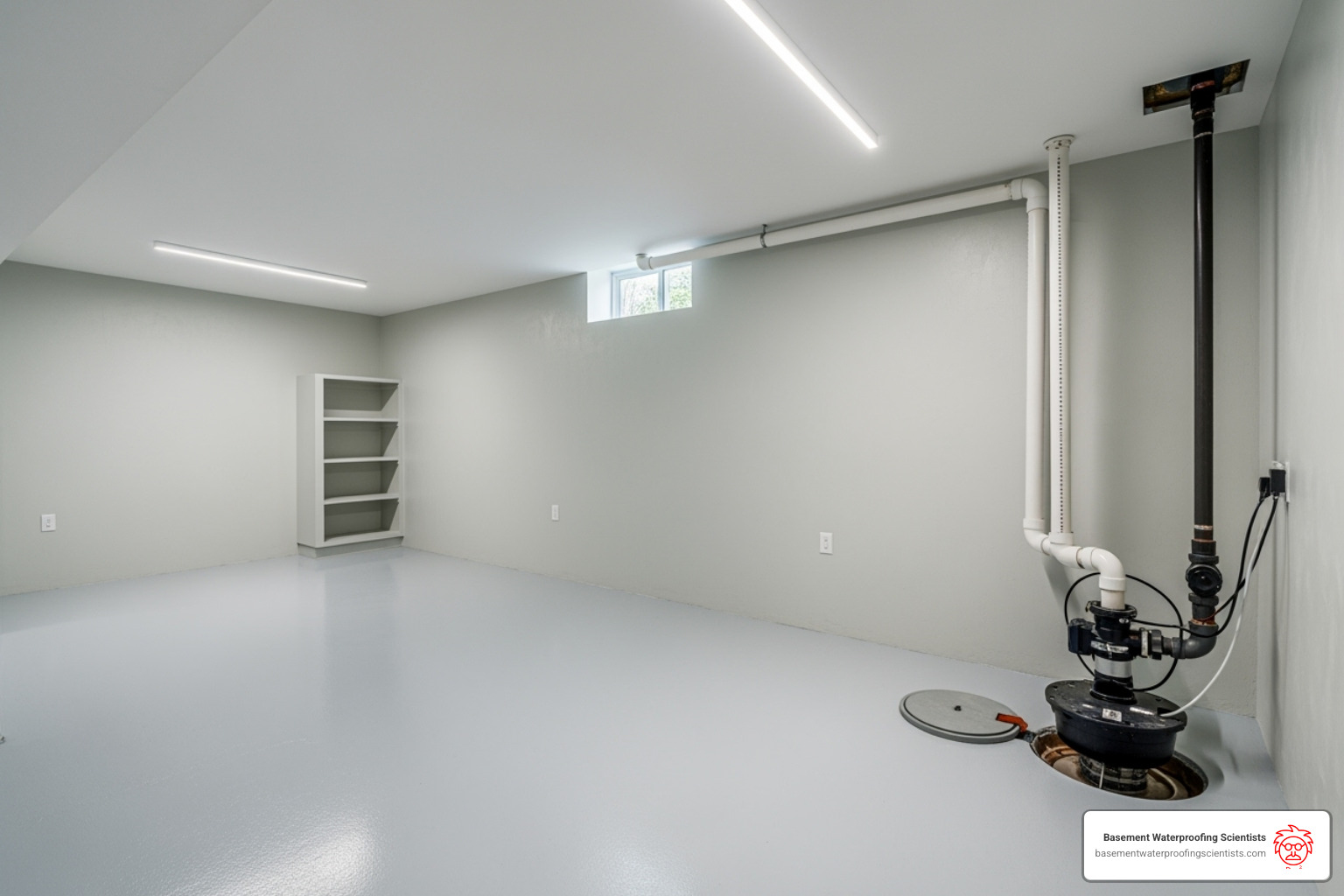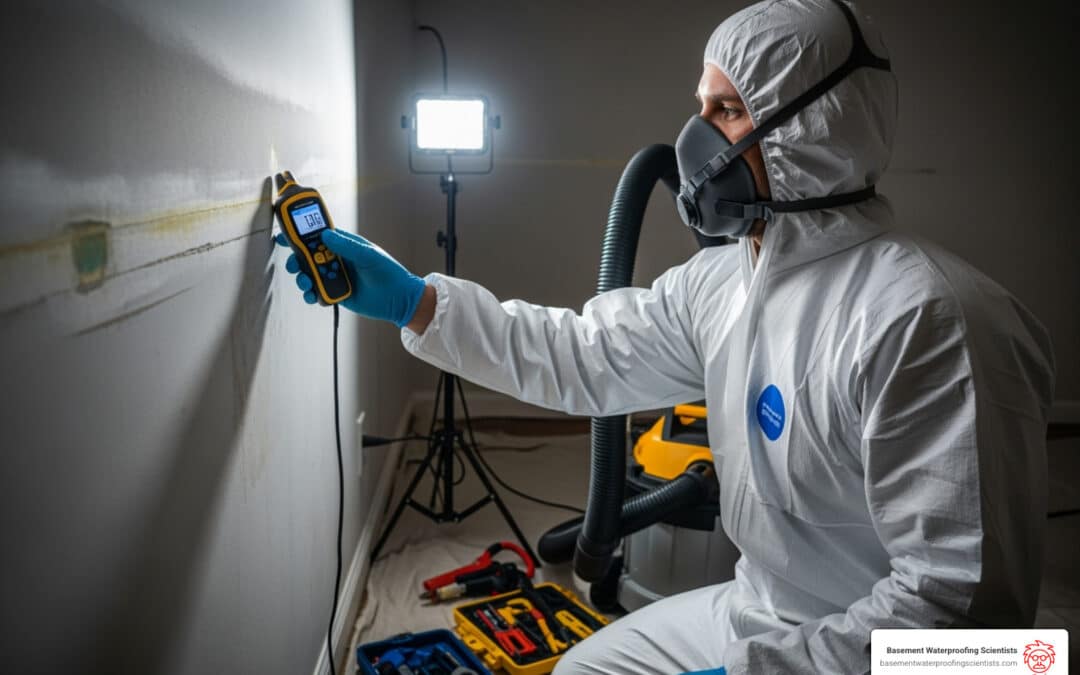Why Quick Action on Mold Testing Remediation Matters
Mold testing remediation is a critical process for protecting your home and health. If you’ve noticed a musty smell, discoloration, or had recent water damage, immediate attention is required. Mold can develop within 24-48 hours of water exposure, turning a small issue into a major health hazard and costly project.
Quick Reference for Mold Testing Remediation:
- Mold Inspection: Visual assessment with moisture meters ($300-$500)
- Mold Testing: Air and surface sampling with lab analysis ($150-$2,700)
- Mold Remediation: Containment, removal, and cleaning ($1,100-$3,300 average)
- Timeline: Mold grows within 24-48 hours of water exposure
- Professional help needed: For areas over 10 sq ft or toxic mold concerns
The good news is that you can take meaningful action within the first hour of finding a potential problem. This guide will help you identify the issue, understand your options, and set a clear plan in motion.
The key is understanding that mold testing remediation isn’t just about removing visible mold—it’s about addressing the underlying moisture problem that allows it to thrive. Without fixing the root cause, the mold will return.
I’m Darin Garvey, and with 30 years of experience in basement waterproofing, I’ve seen how moisture creates the perfect environment for mold. My expertise in mold testing remediation shows that the most effective approach combines immediate assessment with long-term moisture control.

Must-know mold testing remediation terms:
Step 1: Identify Potential Mold Problems (The First 15 Minutes)
The first step in mold testing remediation is determining if you have a problem. Your senses are effective tools, and you can learn a lot in just 15 minutes.
Start with your nose and eyes. A distinctive musty, earthy smell is a clear warning sign of mold, even if you can’t see it. Visually, mold isn’t always black; it can be white, brown, green, or tan, and appear fuzzy, slimy, or like a persistent water stain.
Focus on the usual suspects during your inspection. Basements, bathrooms, and areas around leaky pipes are prime real estate for mold. Don’t forget attics and crawlspaces, where humidity levels are often ideal for mold growth.

Recent water damage is your biggest red flag. If any area wasn’t completely dried within 48 hours of a leak or flood, you have prime conditions for mold. Even minor water events can cause major problems if moisture is trapped behind walls or under flooring.
Important: do not disturb any moldy materials you find. Poking or trying to clean suspicious spots can release billions of spores into the air, worsening the problem and potentially affecting your health.
As basement waterproofing specialists, we use moisture meters and thermal imaging to find hidden moisture sources. We know that indoor moisture levels above 60% create the perfect environment for mold to thrive.
If your 15-minute inspection reveals visible mold, musty odors, or water damage, it’s time to explore your mold testing remediation options.
For more detailed guidance, check out these resources:
- How to Check for Mold in Your House
- Mold in Basement
- Dry Basement Musty Odor: What Could Be Causing It?
Step 2: Understand the Key Differences: Inspection vs. Testing vs. Remediation
In mold testing remediation, you’ll encounter three key terms. Think of them as the detective work, the lab analysis, and the cleanup crew.
| Category | Purpose | Process | When It’s Needed |
|---|---|---|---|
| Mold Inspection | To visually identify mold, find its cause, and assess the extent of the problem. | Visual assessment using tools like moisture meters and thermal imaging to find hidden moisture. | When you see or smell mold, have had water damage, or are buying/selling a home. |
| Mold Testing | To confirm the type and concentration of mold spores, often for legal or health reasons. | Collecting air, surface, or bulk samples for lab analysis. | When mold is suspected but not visible, health issues are a concern, or for post-remediation clearance. Not always necessary if mold is visible. |
| Mold Remediation | To safely remove mold growth and restore the area to a normal, healthy state. | Involves containment, negative air pressure, HEPA vacuuming, removal of contaminated materials, and cleaning. | When mold growth is confirmed (especially over 10 sq ft) or recommended by an inspection. |
Mold inspection is the detective phase and where most homeowners should start. A professional uses tools like moisture meters and thermal imaging to find visible mold and, more importantly, the hidden moisture causing it. A good inspector figures out why the mold is there. Inspections typically run between $300 and $500.
Mold testing is the lab analysis phase. It involves collecting samples to identify the type and concentration of mold. However, if you can already see mold, the EPA and CDC generally don’t recommend testing. The solution is always the same: it needs to be removed. Testing is valuable for suspected hidden mold or for post-remediation clearance to confirm the job was done right. For specific concerns, black mold testing can provide answers.
Mold remediation is the cleanup phase. This is a professional process that involves containment, HEPA filtration, and physical removal of contaminated materials. The goal isn’t to eliminate all mold spores—which is impossible—but to return your home to normal, healthy fungal levels. The process includes setting up containment, using negative air pressure, removing damaged materials, and cleaning salvageable surfaces. Average remediation costs range from $1,100 to $3,300.
The EPA recommends professional help for mold covering more than 10 square feet or when contamination involves sewage. These situations require specialized safety protocols.
Understanding these differences helps you make smart decisions about your mold testing remediation approach.
For more on professional services, see our mold testing and remediation services page.
Step 3: Decide Your Action Plan: DIY vs. Professional Mold Testing Remediation
After identifying a potential mold problem, you must decide between a DIY approach and hiring professionals. This choice is critical for your health, home, and wallet.

The DIY approach to mold testing remediation
A DIY approach may be feasible for very small areas—less than 10 square feet (a 3×3 foot patch)—on non-porous surfaces like tile or glass.
If you tackle a tiny spot, follow these steps:
- Safety First: Always wear an N-95 respirator, gloves, and eye protection to avoid inhaling spores.
- Containment: Close off the room and open windows to ventilate the space and minimize spore dispersal.
- Cleaning: Use simple solutions like baking soda, hydrogen peroxide, or mild detergent. The EPA doesn’t recommend bleach on porous materials, as it’s mostly water and won’t address airborne spores.
- Scrub and Dry: Thoroughly scrub the area and ensure it’s completely dry within 24 to 48 hours to prevent regrowth.
However, DIY has significant limitations. It often falls short for anything more than a tiny surface spot. If mold covers more than 10 square feet, the EPA recommends a professional. Porous materials like drywall, carpet, or wood usually need to be removed and replaced, not just cleaned. If you smell musty odors but see no mold, a DIY approach won’t uncover the hidden source. Disturbing larger mold areas can release hazardous mycotoxins and spread contamination throughout your home.
For more on DIY testing, read our article:
Why professional mold testing remediation is often necessary
For larger or complex infestations, professional mold testing remediation is essential.
- Large Infestations: For areas over 10 square feet, pros have the training and equipment (like HEPA filtration) to handle the job safely.
- Hidden Mold: Professionals use tools like moisture meters and thermal imaging to find hidden moisture sources behind walls or under floors.
- HVAC Contamination: If mold enters your HVAC system, it requires specialized cleaning to prevent spores from spreading throughout your home.
- Porous Materials: Professionals know how to safely remove and dispose of contaminated drywall, insulation, and carpeting to prevent cross-contamination.
- Health Sensitivities: For households with allergies, asthma, or compromised immune systems, professional remediation ensures the environment is returned to safe, normal fungal levels.
- Complete Remediation: Professionals don’t just clean the mold; they address the underlying moisture issue, which is the only way to prevent it from returning. They follow strict protocols for containment, filtration, and cleaning.
- Post-Remediation Verification: Reputable companies recommend clearance testing to confirm that spore counts have returned to normal, healthy levels, providing peace of mind.
When dealing with more than a small spot, professional mold testing remediation is a necessity for your home’s integrity and your family’s health.
For more information:
Step 4: Find and Vet Qualified Professionals
Once you decide on professional mold testing remediation, finding the right company is crucial. Careful research helps you avoid ineffective services and protect your home.
One of the most important rules is this: do not use the same company for both mold inspection/testing and mold remediation. This presents a clear conflict of interest. An independent mold inspector provides an unbiased evaluation of the problem and a clear remediation plan. This separation protects you from unnecessary work or inflated costs. Many reputable remediation companies, including us, prefer to work from a protocol provided by an independent third-party assessor.
For more on this critical separation, see:
With an independent assessment, you can gather quotes for remediation. Here are key questions to ask potential contractors:
- Licensing and Insurance: Do they carry comprehensive liability and workers’ compensation insurance? This protects you and their team.
- Qualifications and Experience: What are their certifications? How many remediation projects have they completed? With 30 years in the business, our team understands the link between moisture control and mold prevention.
- Containment and Process: How will they isolate the area to prevent spores from spreading? Ask for a detailed explanation of their process, from fixing the moisture source to cleaning and sanitizing.
- Post-Remediation Verification: Do they recommend or perform clearance testing (ideally by a third party) to confirm the job was successful?
- Guarantee or Warranty: What kind of written guarantee do they offer? A reputable company stands behind its work. Our lifetime guarantee on waterproofing solutions reflects our commitment to long-term results.
- Scope of Work: Do they handle rebuild services, or will you need other contractors for repairs after the mold is gone?
Be wary of any company that promises 100% mold removal. Since mold spores are naturally everywhere, the goal is to return mold levels to a normal, healthy state, not achieve impossible eradication.
Regarding costs, mold inspection typically ranges from $300 to $500, while the average cost for mold remediation is $1,100 to $3,300. Don’t just choose the cheapest option; focus on the company’s expertise and the comprehensiveness of their solution.
Step 5: The Long-Term Solution: Preventing Future Mold Growth
The most critical part of any mold testing remediation strategy is preventing regrowth. Mold is a moisture problem. If you don’t fix the underlying water issue, you’ll be stuck in a cycle of recurring mold.

Moisture Control is the Ultimate Defense
Mold needs moisture, oxygen, and organic food to grow. You can’t eliminate oxygen or organic materials like wood and drywall, but moisture is the one factor you can control. Our 30 years of experience confirm that proactive moisture management is the best defense. No moisture means no mold growth.
Creating an Uninhabitable Environment for Mold
The key to long-term prevention is keeping indoor humidity below 45 percent, which prevents mold from establishing itself. This is especially important in basements and crawl spaces, where standard dehumidifiers often fail in the cooler temperatures. You need equipment designed for these subterranean spaces.
Water damage not addressed within 24-48 hours can lead to mold. That small leak is a breeding ground for mold colonies. Fixing leaks early prevents the much more expensive problem of mold testing remediation later.
The Stack Effect: How Your Basement Affects Your Whole House
Air naturally rises from your basement or crawl space throughout your home in a process called the “Stack Effect.” This means mold spores from a damp basement circulate through your entire house, affecting air quality everywhere. This is why proper ventilation in bathrooms and kitchens is crucial, and why water must be directed away from your foundation.
Our Comprehensive Approach to Moisture Control
As Basement Waterproofing Scientists, we address moisture at its source. Our Basement Drainage System and Sump Pump for Basement installations work together to channel and remove water from your home. For crawl spaces, our Crawlspace Waterproofing and Encapsulation services seal out ground moisture and control humidity.
Sometimes, foundation cracks are the direct cause of water intrusion. We provide expert structural repairs to fix the immediate problem and prevent future leaks. The average cost for basement waterproofing is between $4,000 and $8,000—a worthy investment compared to the health hazards and damage from mold. Our competitive pricing and lifetime guarantee ensure a permanent solution.
By implementing these preventative measures, you’re not just performing mold testing remediation—you’re safeguarding your home’s long-term health.
Learn more about preventing mold:
Frequently Asked Questions about Mold
What are the potential health hazards associated with mold exposure?
Understanding the health risks of mold is crucial. Exposure affects people differently, but common symptoms often mimic allergies.
- Common symptoms include itchy eyes, runny nose, coughing, and nasal congestion. Headaches are also frequent.
- Asthma triggers: For those with asthma, mold can trigger severe attacks.
- Serious reactions can include respiratory irritation of the eyes, skin, nose, and lungs, as well as persistent flu-like symptoms like fatigue and body aches.
- Vulnerable populations like the elderly, young children, and those with compromised immune systems face higher risks.
- Mycotoxin exposure is a major concern. Some molds produce toxins that, with prolonged exposure, have been linked to serious neurological symptoms like memory loss, insomnia, anxiety, and confusion.
If you experience unexplained health symptoms and suspect mold, seek medical attention and address the mold problem promptly through proper mold testing remediation.
For more information:
Can all mold be completely removed from a property?
No, it’s impossible to completely remove all mold from a property, and any company claiming 100% removal is misleading you. Mold spores are a natural part of our environment, both indoors and outdoors.
The real goal of mold remediation is not to create a sterile environment but to return indoor mold levels to “normal fungal ecology”—that is, levels similar to the healthy outdoors. This is why we use the term “remediation” instead of “removal.” Remediation focuses on eliminating visible growth and, most importantly, addressing the moisture source that allowed it to thrive. Without fixing the moisture problem, mold will almost certainly return.
Is mold damage typically covered by homeowner’s insurance?
Insurance coverage for mold damage depends on your policy. There is no universal answer.
- When it might be covered: Policies are more likely to cover mold damage resulting from a “sudden and accidental” event, like a burst pipe or storm damage.
- When it’s typically not covered: Mold from long-term issues like gradual leaks or chronic humidity is usually considered a maintenance problem and is not covered.
- Policy limits: Many policies have specific mold exclusions or sub-limits (e.g., $1,000 to $5,000), which may not cover the full cost of mold testing remediation.
We recommend reviewing your policy or contacting your agent to understand your specific coverage. Regardless of insurance, addressing mold promptly is crucial for your home and health. Prevention through waterproofing is always a better investment than remediation.
Protect Your Home by Addressing the Root Cause
Taking quick action on mold testing remediation is about making smart, informed decisions. You’ve learned how to identify problems, understand the key services, and decide when to call a professional.
The most important takeaway is that mold is a moisture problem. You can clean visible mold, but if you don’t fix the underlying water issue, it will always return.
The steps to a mold-free home are:
- Identify the problem quickly.
- Understand the difference between inspection, testing, and remediation.
- Act based on the scope of the issue.
- Prevent future growth by controlling moisture at its source.
This is where our 30 years of expertise as Basement Waterproofing Scientists is invaluable. We use specialized equipment to find and fix leak sources, providing comprehensive and permanent solutions.
Real prevention means addressing the root cause, whether it’s a damp basement, a humid crawl space, or foundation cracks. The air in your basement circulates throughout your home due to the stack effect, so tackling moisture at its source protects your foundation and your family’s health.
Don’t wait for a small moisture issue to become a major mold crisis. Invest in a real solution. With our competitive pricing and lifetime guarantee, you’re not just fixing today’s problem—you’re preventing tomorrow’s.
Contact us for professional mold testing and remediation services


